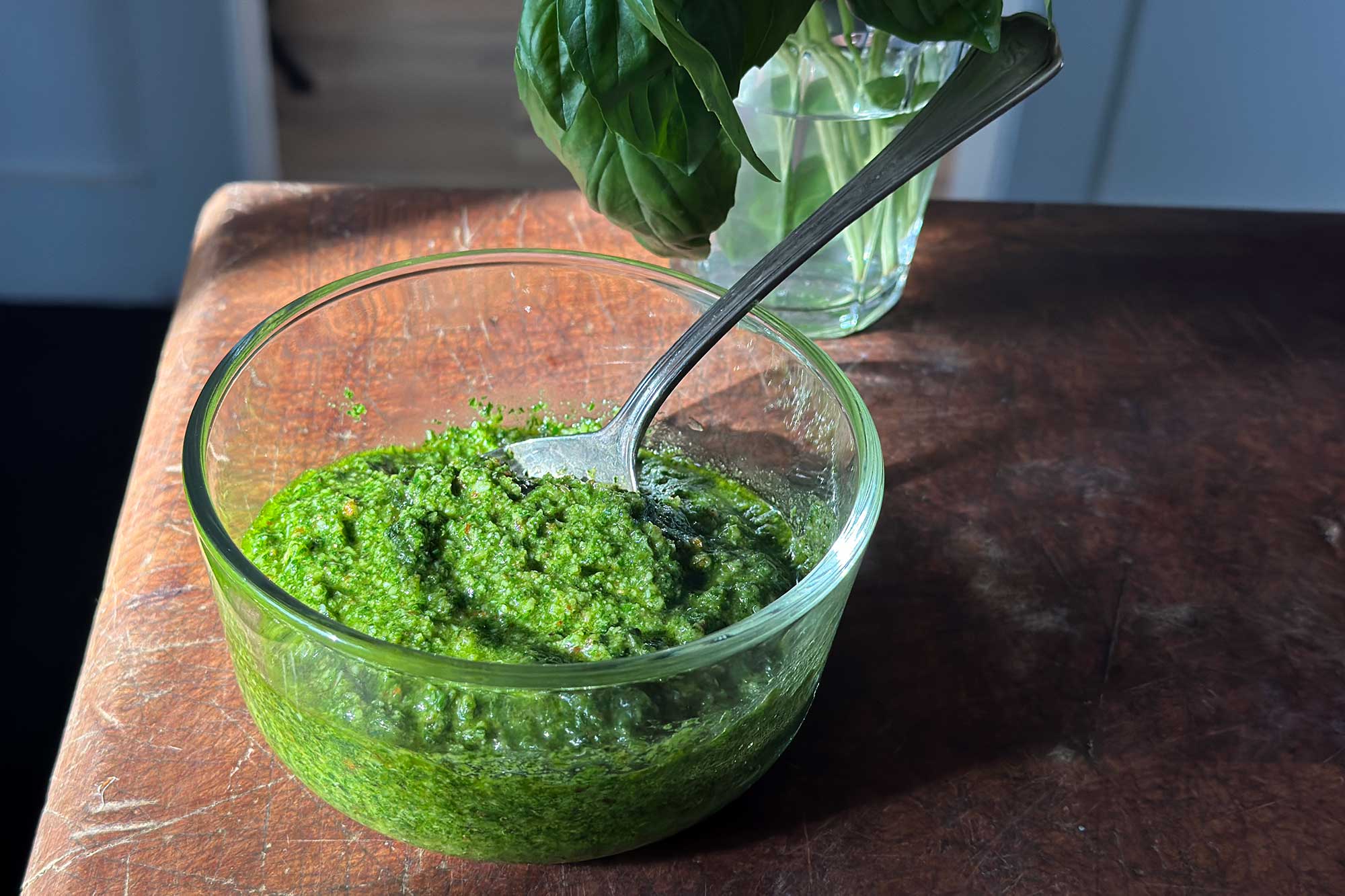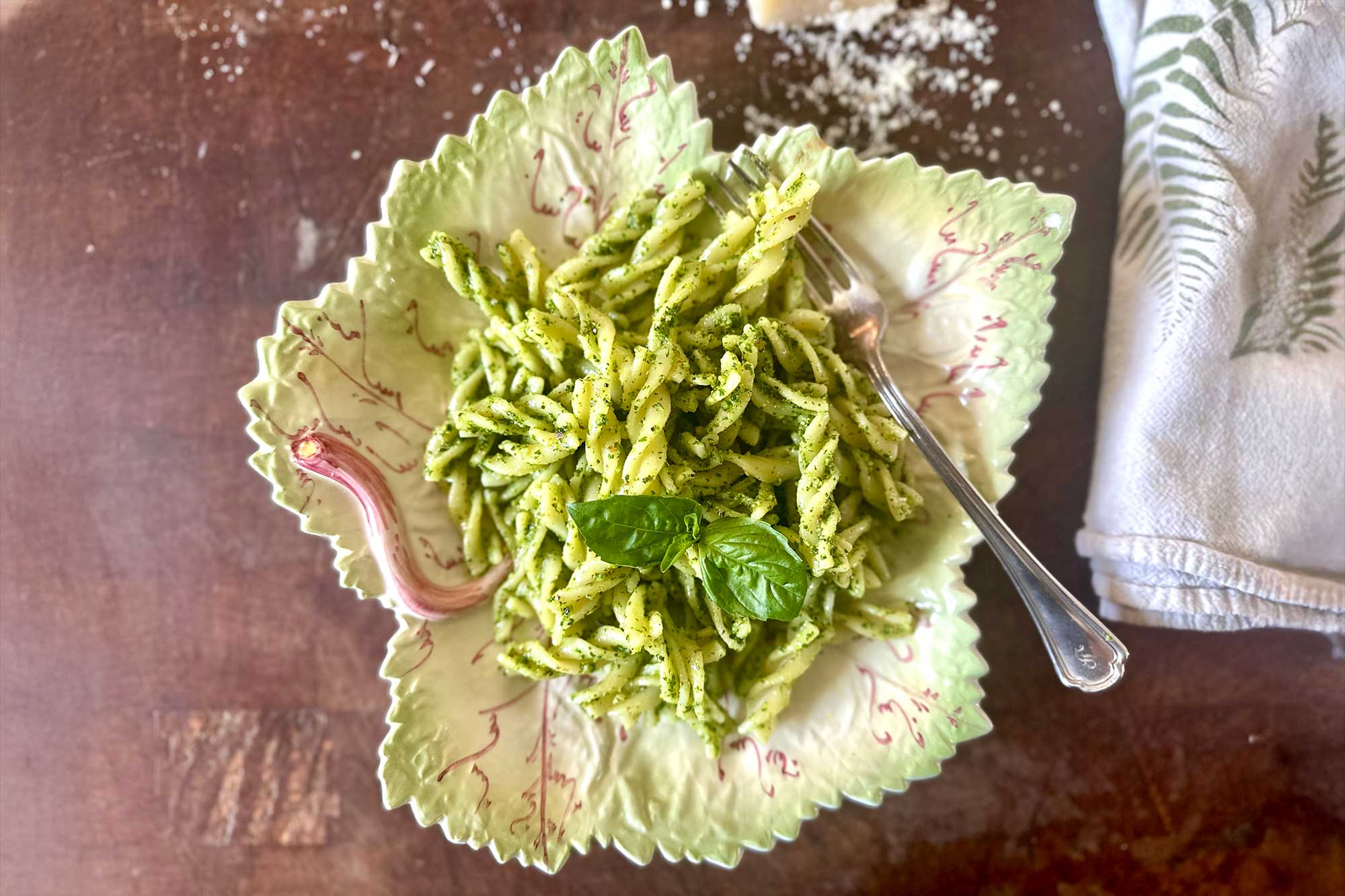This story is part of Technique Toolbox, a series in which top chefs and cookbook authors share the methods that unlock delicious planet-friendly or low-waste dishes.
Pesto, the beloved classic from Italy’s Liguria region, exemplifies a key tenet of that nation’s cuisine: Start with the highest-quality components and enhance them just enough to make them sing. “The simpler the recipes, the more that’s going to be in play,” says Cathy Whims, chef-owner of Nostrana in Portland, Oregon, and author of the new cookbook The Italian Summer Kitchen.. “So shopping well becomes a big part of making food that’s that simple.”
Pesto has endless variations, only a handful of ingredients, and takes mere minutes to make. But if it’s so easy, why do many homemade versions look and taste less than vibrant? Because cooking in a way that lets the ingredients sing leaves nothing to hide behind, and a lot of the magic is in the technique. So we asked Whims to walk us through her pesto-making process, which includes a couple of surprises for unlocking the saucy staple—and readying a stash to last all year long.
The technique
In the most basic of pesto recipes, fresh basil, garlic, pine nuts, parm, and olive oil get quickly blitzed together in a food processor, or ground together in a mortar and pestle. While there’s nothing wrong with that approach, Whims’ method involves a couple of key tricks. First is to pretreat the basil leaves by giving them a quick blanch. Second is to add the oil as slowly as possible while the mixture blends.
That’s for the fresh stuff, but pesto is a make-ahead classic—something generations of cooks have batched in the warmer months to freeze and eat over the course of the year. If that’s your plan, Whims has some advice: Leave out the garlic and cheese, and add it in when you’re ready to eat your sauce.
Why it works

We’ll start with the star of the show: the basil. Blanching deactivates enzymes in the herb that can otherwise lead to browning of the leaves. “I always blanch it, because I think it makes for a much more beautiful pesto, emerald green, without losing any flavor, and the perfume of the basil stays intact,” Whims says.
When it comes to bringing a pesto together, adding the oil very slowly is the secret to literally mixing oil with watery basil. “If you add it too fast, it won’t emulsify,” Whims says. Unlike mayonnaise, which contains egg yolk that helps bind oil and water molecules, pesto relies on the slow blending process to stabilize the mixture and keep the fats from separating (much) in the finished product.
When it comes to the deep freeze? Even though the sauce remains relatively inert in the chiller, Whims says the garlic gets too strong and starts to dominate. That’s because freezing breaks down cell walls, which can let too much flavor loose once ingredients thaw. Cheese, meanwhile, changes in texture, because ice crystals mess with its protein structure. This is less problematic with hard cheeses, but Whims says the difference is noticeable. “It just gets weird,” she says. She’s not alone: Famed Italian cookbook author Marcella Hazan also touted this tip.
Variations
Pesto, though it has a classic version, can be more of an equation than a recipe: greens + nuts + garlic + cheese + oil = sauce. Once you’ve got it down, you can mix and match based on your tastes and what’s in season. In her book, for instance, Whims includes a version that swaps basil for arugula. “My best basil grows in the summertime, and it starts sort of fading out as the weather gets cooler.” Arugula, on the other hand, turns sharper when the weather gets hot. At Nostrana they’ve made pesto with asparagus, and Whims adds that green beans would be great too.
As for the cheese, any firm grating formaggio—or plant-based version—can work in place of the parm. Some nontraditional pesto recipes, including one in The Italian Summer Kitchen, call for ricotta. “I can almost see tofu being substituted,” Whims says.

This article originally appeared in the
Cool Beans newsletter.
Read the whole story here.

